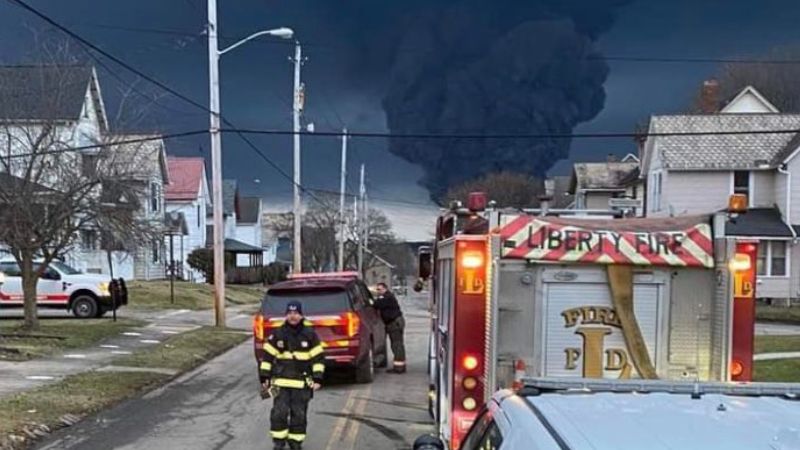Ohio Train Derailment: Lingering Chemical Contamination In Buildings

Table of Contents
Extent of Building Contamination
The volatility of the released chemicals, especially vinyl chloride, poses a significant threat. Its ability to penetrate various building materials necessitates a thorough investigation into the scope of contamination.
Vinyl Chloride Penetration
Vinyl chloride, a known carcinogen, is highly volatile and readily disperses in the air. This poses a significant challenge in containing its spread.
- Air infiltration: The initial explosion and subsequent burning of vinyl chloride created a plume of toxic chemicals that infiltrated homes and businesses through open windows, doors, and ventilation systems.
- Settling dust: The released chemicals likely settled as dust particles on surfaces, including floors, furniture, and even within wall cavities, leading to long-term exposure risks.
- Studies on similar incidents: Past incidents involving chemical spills and fires have demonstrated the capacity of volatile organic compounds (VOCs) to penetrate building materials, lingering for extended periods. Studies on similar incidents involving other VOCs highlight the potential for long-term contamination and the need for extensive remediation efforts.
Other Hazardous Chemicals
Beyond vinyl chloride, the derailment released other hazardous chemicals, each with its own potential for lingering contamination.
- Butyl acrylate and ethylhexyl acrylate: These are other chemicals released in the derailment, known for their potential respiratory and skin irritations, and long-term health effects if inhaled or absorbed through the skin. These chemicals can adhere to surfaces and remain present long after the initial release.
- Persistence in building materials: The specific persistence of these chemicals varies depending on the building materials involved. Porous materials like wood and insulation are more susceptible to absorption, making remediation more complex. Non-porous materials like metal may retain contaminants on the surface.
Potential Long-Term Health Effects
Exposure to the chemicals released in the Ohio train derailment poses significant long-term health risks to residents.
Respiratory Issues
Inhalation of vinyl chloride and other released chemicals can lead to a range of respiratory problems, both short-term and long-term.
- Short-term effects: These include coughing, wheezing, shortness of breath, and irritation of the nose and throat.
- Long-term effects: Chronic exposure can cause more serious conditions such as asthma, chronic obstructive pulmonary disease (COPD), and lung cancer. Studies have clearly linked long-term exposure to similar volatile organic compounds to the development of severe respiratory illnesses.
Cancer Risks
Many of the released chemicals are known or suspected carcinogens, increasing the risk of various cancers with prolonged exposure.
- Potential cancers: Vinyl chloride is strongly linked to liver cancer, brain cancer, and lung cancer. Other released chemicals may also contribute to an increased risk of other types of cancers.
- Research and studies: Numerous epidemiological studies have established links between exposure to these chemicals and increased cancer rates in affected populations.
Other Health Concerns
Beyond respiratory issues and cancer risks, exposure to these chemicals can cause a range of other health problems.
- Neurological effects: Some of the released chemicals are neurotoxins, potentially affecting the nervous system and causing neurological disorders.
- Reproductive issues: Exposure can also impact reproductive health, leading to infertility or birth defects.
- Ongoing medical evaluation: It is crucial for residents to undergo regular medical evaluations to monitor their health and detect potential problems early.
Cleanup and Remediation Efforts
Addressing the contamination in buildings requires a multi-pronged approach focusing on immediate cleanup and long-term monitoring.
Current Cleanup Strategies
The ongoing cleanup efforts involve various strategies to remove or mitigate the contamination.
- Air filtration: High-efficiency particulate air (HEPA) filters are used to remove airborne contaminants from the indoor environment.
- Surface cleaning: Decontamination of surfaces involves specialized cleaning techniques to remove settled chemicals.
- Limitations: The effectiveness of these methods varies depending on the type of building material, the extent of penetration, and the specific chemicals involved. Complete removal of deeply embedded contaminants may be challenging.
Long-Term Monitoring
Continuous monitoring is essential to ensure the safety of residents in the long term.
- Air and surface testing: Regular air and surface testing should be conducted to assess the levels of remaining contaminants.
- Regulatory oversight: Government agencies must play a crucial role in overseeing the cleanup and long-term monitoring efforts, guaranteeing transparency and accountability.
Government Response and Accountability
The government's response to the crisis is critical for the health and well-being of affected residents.
- Investigations: Thorough investigations are necessary to determine the cause of the derailment and identify any regulatory failures that contributed to the incident.
- Support for residents: Adequate support for affected residents must include access to medical care, relocation assistance, and financial aid for property remediation. The extent and effectiveness of this support remain a subject of ongoing scrutiny and debate.
Conclusion
The Ohio train derailment has left a legacy of chemical contamination in buildings, posing significant long-term health risks to residents. The potential for persistent exposure to vinyl chloride and other hazardous chemicals necessitates thorough cleanup, ongoing monitoring, and robust government oversight. The long-term consequences of this disaster highlight the critical need for stricter regulations and greater accountability in the transportation and handling of hazardous materials. We must demand transparency and continued action from those responsible to ensure the safety and well-being of the affected community. Stay informed, support affected residents, and contact your elected officials to demand accountability and prevent future incidents of Ohio train derailment-style chemical contamination.

Featured Posts
-
 Canada Post Facing Strike How Will Customers React
May 27, 2025
Canada Post Facing Strike How Will Customers React
May 27, 2025 -
 Bandidos Atacam Policiais Cerco Rompido Dois Feridos
May 27, 2025
Bandidos Atacam Policiais Cerco Rompido Dois Feridos
May 27, 2025 -
 Blake Lively Justin Baldoni And A Wake Up Call Selena Gomezs Claims And Taylor Swifts Response
May 27, 2025
Blake Lively Justin Baldoni And A Wake Up Call Selena Gomezs Claims And Taylor Swifts Response
May 27, 2025 -
 Nimechchina Nadast Ukrayini E11 Mlrd Viyskovoyi Pidtrimki Do 2029 Roku Podyaka Umyerova
May 27, 2025
Nimechchina Nadast Ukrayini E11 Mlrd Viyskovoyi Pidtrimki Do 2029 Roku Podyaka Umyerova
May 27, 2025 -
 Avrupa Merkez Bankasi Ve Trump Gelismelerin Ekonomik Etkileri
May 27, 2025
Avrupa Merkez Bankasi Ve Trump Gelismelerin Ekonomik Etkileri
May 27, 2025
